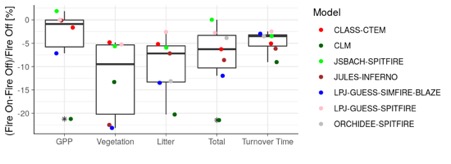Terrestrial ecosystems, particularly large forests, represent an important source of carbon uptake and storage, but their capacity to do so can be impacted by the occurrence of fire. Other factors, such as drought and herbivory also interact within ecosystems, making it difficult to determine to what extent fire impacts the carbon cycle, and therefore how important fire might be for climate change mitigation.
The effects of fire on tree cover and carbon storage can be estimated through experimental approaches, however they tend to be site-specific and focus on fire-prone regions. Models are therefore needed for global estimates over longer time periods. There have been several studies estimating fire impact on the carbon cycle using global vegetation models, but results are conflicting and there are uncertainties in their estimates.
FireMIP (Fire Model Intercomparison Project), a collaboration of more than 30 scientists, from the UK, France, Germany, Sweden, Switzerland, Australia, USA, Canada, China and South Africa, has sought to address this problem by creating the first multi-model assessment of the impact of fire on vegetation distribution and the carbon cycle. In a new study published in Global Change Biology, led by Gitta Lasslop from the Senckenberg Biodiversity and Climate Research Centre, they present what they consider to be the best estimate of global fire effects on ecosystems to date.
Prof. Sandy Harrison, based at the University of Reading, and Associate Director at Leverhulme Centre for Wildfires, Environment and Society, was one of the leads in designing the study and conducting the analysis. “Early model-based studies of the impact of fire on tree cover and carbon storage were tantalising but, since they only used one model, it was difficult to know how much trust to place in the results. Now we’ve used a range of state-of-the-art fire-enabled vegetation models to examine this question and this gives us some confidence that we have the right ballpark estimate” explains Prof. Harrison.
By comparing scenarios where fire is completely suppressed with historical simulations of fire occurrence, the study found that fire reduces tree covered area and vegetation carbon storage by 10% globally, with a range of 3-25% between the different models. In savanna regions, which were found to experience the strongest impact of fires overall, the average reduction in vegetation carbon was 17%. Although considerable, these estimates were actually lower than previous studies. This can be attributed to the inclusion of anthropogenic change in land-use, which reduces the impact of fire on tree cover, but which was not included in previous studies. The team also found that spatial patterns of tree cover are much improved when fire is taken into account, demonstrating the importance of representing fire in dynamic vegetation models.

Fire has been a part of the earth system for at least 470 million years, and this study confirms that fire still has an important role in shaping ecosystems in present-day conditions. The results, based on recent data (2001-2012), also imply that future changes in fire occurrence will impact the capacity of terrestrial ecosystems to uptake and store carbon, and that fire should be taken into account in the context of climate change mitigation and adaptation.






